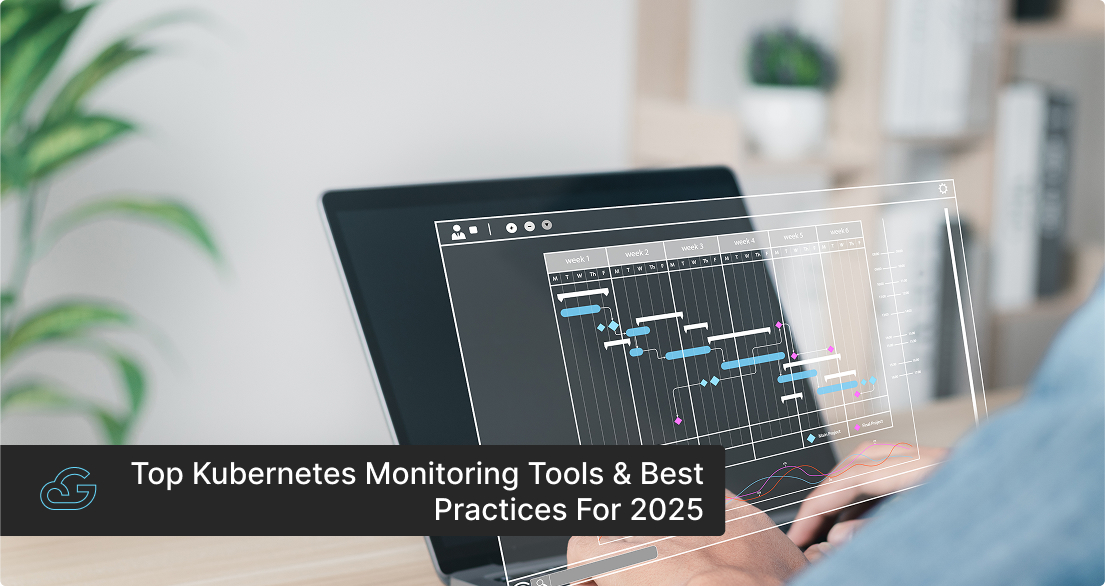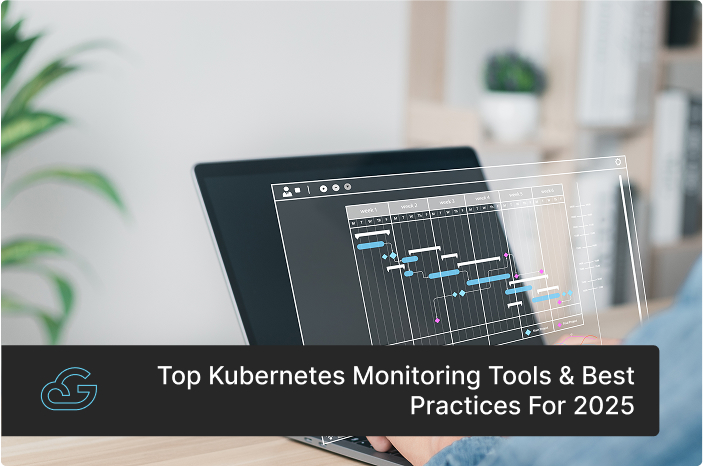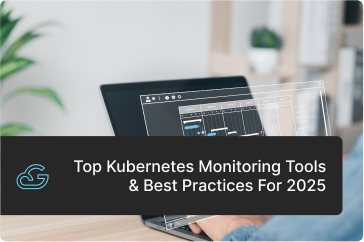Blogs / Kubernetes
Top Kubernetes Monitoring Tools & Best Practices for 2025
By
Vineeth Babu
Posted: May 21, 2025
• 9 Minutes
Kubernetes is the de facto container orchestration platform for modern-day organizations. It ensures that your application continues to operate at an optimal level by managing Kubernetes clusters comprising numerous nodes, pods, and containers. But as these clusters start growing in number, performance and security issues will start cropping up. To tackle these issues, you need to ensure total visibility into your Kubernetes environment. And that’s exactly what Kubernetes monitoring is all about.
What is Kubernetes Monitoring?
Kubernetes monitoring refers to the practice of analyzing the health and performance of your Kubernetes clusters, which include various nodes, pods, and containerized applications. With a comprehensive Kubernetes monitoring process, you can maintain consistent performance and proactively detect security issues, ensuring the stability of your containerized applications.
Why is Kubernetes Monitoring Important?
- Boosts System Reliability: You can proactively detect performance degradation, failing nodes, and unhealthy pods before they cause downtime. By continuously monitoring key metrics, you can ensure a stable and highly available environment for end-users.
- Improves Resource Utilization: With real-time insights into CPU, memory, and storage usage, you can prevent over-provisioning or under utilization. This enables efficient autoscaling, reducing operational costs while maintaining performance.
- Enhances Application Security: Kubernetes monitoring helps detect security anomalies, such as unauthorized access, excessive API calls, or unusual traffic patterns, allowing you to mitigate threats before they escalate.
- Simplifies Compliance Adherence: Continuous monitoring ensures that clusters adhere to security frameworks like SOC 2, HIPAA, or GDPR by tracking configurations, access controls, and audit logs.
- Streamlines Kubernetes costs: By analyzing workload patterns and identifying unused or underutilized resources, you can optimize cloud spending. Cost monitoring tools also help predict and manage expenses effectively.
- Improves Incident Management: Automated alerting and event tracking help your teams respond to failures and misconfigurations in real time. With detailed logs and telemetry data, you can quickly diagnose and resolve issues, reducing Mean Time to Resolution (MTTR).
- Enhances Troubleshooting: Centralized logging and monitoring provide deep visibility into your cluster’s state. By correlating logs, metrics, and traces, you can pinpoint root causes faster, minimizing downtime and operational disruptions.
 Also Read
Also Read
Kubernetes Monitoring vs. Kubernetes Observability vs. Kubernetes Debugging
- Kubernetes Monitoring: Kubernetes monitoring involves tracking your system’s health and performance using predefined metrics such as CPU usage, memory consumption, and network traffic.
- Kubernetes Observability: Kubernetes observability goes beyond monitoring and provides deeper insights into system behavior by analyzing logs, metrics, and traces. It will help you understand how different components interact, create plans to diagnose complex issues, and proactively enhance the reliability of applications.
- Kubernetes Debugging:Kubernetes debugging refers to the process of identifying and resolving specific issues within clusters, pods, or workloads. It involves analyzing logs, inspecting container states, and running diagnostic commands to pinpoint failures or misconfigurations.
Important Metrics in Kubernetes Monitoring
Now that you have understood the significance of Kubernetes monitoring, let’s look at some of the key metrics involved in this entire process. Identifying and analyzing the right metrics will enable you to acquire comprehensive insights. But to do so, you must start by segregating your Kubernetes environment into different levels—Infrastructure, Platform, and Application.
Let’s start by examining the important metrics at the Infrastructure Level:
Let’s move on to the Platform Level next. But what exactly is it? The platform level is the operational backbone of your Kubernetes engine, featuring the control plane and its components. Here are the key metrics you should try to track at this level.
We have covered the major metrics that you must measure in the infrastructure and platform level. Now, let’s explore the final one—Application level.
Top 10 Kubernetes Monitoring Tools in 2025
From the previous section, you would have a fair idea about the important Kubernetes metrics that you should monitor. But monitoring manually is going to be tedious. Instead, you must use Kubernetes monitoring tools. Let’s go through some of the top Kubernetes monitoring tools currently available in the market.
- Kubernetes Dashboard: The Kubernetes Dashboard is a widely used web-based graphical user interface that provides real-time insights into cluster health, workloads, and resource utilization. It allows you to view pod status, node performance, deployment details, and resource usage at a glance. However, you must remember that it is not a full-fledged observability tool, making it best suited for quick visual inspections rather than in-depth monitoring.
- Prometheus: Prometheus is a go-to open-source Kubernetes monitoring solution that uses a unique and powerful query language called PromQL to collect and store time-series data. It pulls metrics from Kubernetes components like API server, Kubelet, and cAdvisor and provides visibility into CPU/memory usage, pod health, and network traffic. With its built-in alerting feature, Prometheus helps teams detect and respond to resource bottlenecks, failures, and anomalies in real time.
- ELK: The ELK stack is a collection of tools—Elasticsearch, Logstash, and Kibana—that is widely used for log aggregation and analysis in Kubernetes environments. In the stack, Elasticsearch indexes and searches logs, Logstash processes and transforms log data, and Kibana visualizes insights through dashboards.
- Jaeger: Jaeger is a distributed tracing tool that can help you analyze request flows and latency across microservices running in Kubernetes. By collecting traces from applications, it can enable you to monitor request latencies, identify delayed services, and visualize complex dependency chains in cloud-native architectures.
- Loki: Loki is a log aggregation tool that is modeled to work with other tools like Prometheus and Grafana. Unlike traditional log management solutions, Loki indexes metadata instead of full log content, making it cost-effective and scalable for Kubernetes logging. It will help you analyze application logs, correlate logs with metrics, and troubleshoot issues without excessive storage overhead.
- Grafana: Grafana is a powerful visualization tool that can be integrated with Prometheus, Loki, and other data sources. It provides deep insights into your Kubernetes clusters by displaying CPU and memory usage, network traffic, request latency, and application-specific metrics. With its flexible alerting system, Grafana also helps your platform engineers track trends, detect anomalies, and optimize resource allocation efficiently.
- Splunk: Splunk is an enterprise-grade observability and security tool that provides deep insights into Kubernetes environments. It ingests logs, metrics, and traces to detect security threats, analyzes infrastructure performance, and tracks resource utilization. With AI-powered analytics and automated alerts, Splunk is a strong choice for large-scale organizations needing advanced Kubernetes monitoring and compliance reporting.
- KubeShark: KubeShark is an API traffic analyzer that will help you inspect network traffic, debug microservices communication, and detect anomalies in API calls. With deep packet inspection and service-to-service monitoring, KubeShark is useful for diagnosing connectivity issues, troubleshooting ingress/egress traffic, and ensuring secure communication within clusters.
- New Relic: New Relic can automatically collect infrastructure metrics, logs, traces, and events to provide visibility into application performance and dependencies. Its auto-instrumentation for Kubernetes workloads makes it easier to monitor resource consumption, detect performance bottlenecks, and optimize service reliability.
- Kubewatch: Kubewatch is a Kubernetes monitoring tool that sends real-time notifications to Slack, Microsoft Teams, or other collaboration platforms when changes occur in clusters. It can track deployments, pod status changes, and config updates, helping you stay aware of modifications and potential failures. While it does not provide deep observability, Kubewatch is valuable for event-driven monitoring and incident response.
Best Practices for Effective Kubernetes Monitoring in 2025
- Look Out for End-User Experience: system health is not enough—you need to track how your application behaves under real-world conditions. Use request latency, error rates, and service-level objectives (SLOs) to measure actual user impact. For example, if a pod restart increases response time, the issue may not be the restart itself but an inefficient retry mechanism. By focusing on user-facing metrics, you can prioritize fixes that improve application responsiveness rather than just stabilizing infrastructure.
- Use Resource Tags and Labels: Kubernetes’ dynamic nature makes it challenging to track workloads, especially in multi-tenant clusters. Properly tagging resources with labels like ‘app’, ‘environment’, and ‘version’ ensures that monitoring data remains structured. This will help you correlate logs, group metrics, and isolate performance issues faster. For instance,when a deployment fails, filtering logs by namespace and deployment can pinpoint the root cause in seconds rather than sifting through raw data.
- Do Not Measure Individual Containers in Isolation: Monitoring an individual container’s CPU or memory usage without context can lead to misleading conclusions. Kubernetes schedules workloads dynamically, and a pod may run efficiently while its node struggles with resource contention. Instead of isolated metrics, track aggregated resource consumption at the pod, node, and cluster levels.
- Add Provisions for Scaling: Your monitoring system must scale alongside your Kubernetes workloads, or it becomes another bottleneck. As your cluster grows, metric ingestion, storage, and query performance must keep up. For example, you must ensure that your data retention rules are set up in a way that the most recent data is collected in detail while older data gets compressed or summarized to save space.
Embrace Proactive Kubernetes Monitoring with Gsoft
Leverage Gsoft’s managed Kubernetes services to ensure seamless cluster management and round-the-clock monitoring. Our experts help you build high-performing Kubernetes environments while proactively identifying and resolving performance or security issues. With our round-the-clock technical support, you get real-time insights, optimized resource utilization, and enhanced reliability for your workloads.
- 24/7 Monitoring & Support: Stay ahead of performance issues with real-time insights and expert assistance
- Proactive Issue Resolution: Detect and resolve bottlenecks before they impact your workloads
- Optimized Resource Utilization: Ensure efficient scaling and cost-effective Kubernetes operations
- Security & Compliance: Continuous monitoring to identify vulnerabilities and maintain compliance
- End-to-End Kubernetes Management: From cluster setup to ongoing performance tuning, we’ve got you covered
Are you struggling with Kubernetes monitoring? Let’s help you. Connect with our experts here, Contact Us!


Get Know More About Our Services and Products
Reach to us if you have any queries on any of our products or Services.










